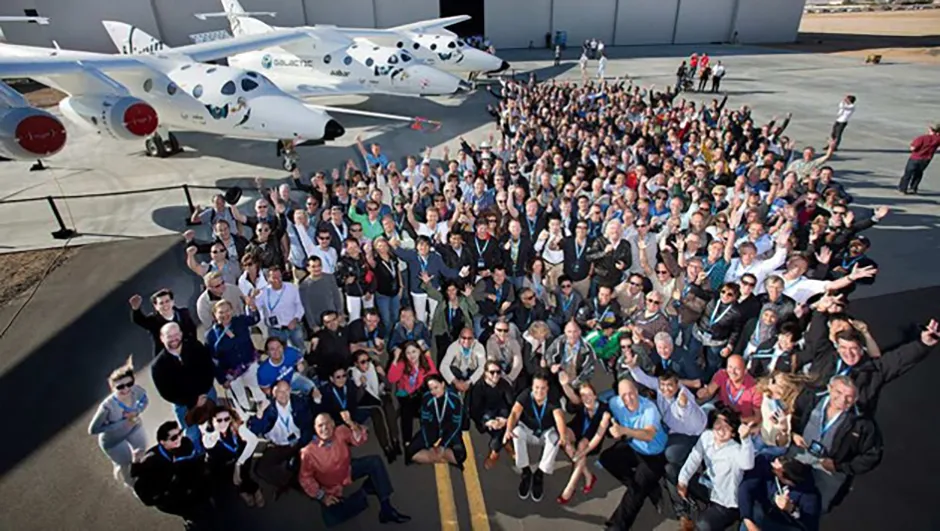SpaceShipTwo during powered flight above the Earth's surface. Image Credit: Virgin Galactic
Virgin Galactic is set to send paying customers into space from 2017 on board its SpaceShipTwo spacecraft.
Along with companies such as Blue Origins and SpaceX making inroads into the world or reusable rocketry, it looks like commercial spaceflight is finally reaching fruition.
"Everybody wants to go to space, that’s clear," said former Virgin Galactic president Will Whitehorn while speaking at the Cheltenham Science Festival on 11 June (seated in below image, Stephen Attenborough on right).
“But unless something changes for most people that won't happen.”
In 2004 entrepreneur Richard Branson set up Virgin Galactic with the aim of transporting tourists to space at an affordable price. But in the 12 years since, the company has been beset by problems and delays.
“We all knew that this was going to take longer than we thought and cost more than we thought from day one,” said Whitehorn.
“There is no silver bullet for getting into space. It’s a radioactive vacuum. But we like a challenge.”
The company was getting ready to send customers into space two years ago, but tragedy put a hold on their plans.
On 31 October 2014 their first test vehicle, VSS Enterprise, crashed in the Mojave Desert in California resulting in the death of co-pilot Michael Albury.
Later inquiry discovered that a human error had caused the craft to tumble and break apart.
VSS Enterprise crash
This was a particular blow, as the basic design of SpaceShipTwo was envisioned as a way to eliminate the dangers of human or computer error during the most difficult and dangerous part of any space journey – re-entry.
The craft acts like a shuttlecock, using its weight to keep it orientated correctly, while its shape acts to stabilise the craft.
By relying on the infallible laws of physics rather than human or electronic judgement, SpaceShipTwo should have been much safer than its predecessors.
However, during the VSS Enterprise’s final ascent, Albury released the mechanism that would allow for this re-entry procedure 14 seconds too early, resulting in the break up of the craft.
“Ironically the mechanism was included as a safety feature,” said Whitehorn.
“It could have been designed better to stop an accident from happening.”
For the next two years, Virgin Galactic went back to its designs to make sure it learned from its mistakes.
"We’ll never know what Albury was thinking, but we all have our momentary lapses of judgement.
We looked at every part of our spaceship and found every single point of human error to make sure it doesn't happen again," said Stephen Attenborough, Virgin Galactic's chief commercial officer also speaking at the Cheltenham Science Festival.
"Now I hope to be making my first flight next year."
A new brand of astronaut
Attenborough is not alone is his excitement about his impending spaceflight.
Hundreds of people have already paid the $250,000 (originally $200,000) ticket fee to become one of the company’s first astronauts.
Following the 2014 crash, only 24 customers asked for refunds on their tickets.
“We asked people ‘Hey, we don’t know what you’ll be getting, who will be eligible to fly or when it will be ready, but who wants to give us $200,000?’
We have over 700 astronauts signed up, more than have ever flown in space in the history of the world,” says Attenborough.

Resuable spacecraft
We are standing at the dawn of commercial space flight, but there are still many challenges that need to be surmounted before it can be performed on a large scale.
The biggest of these is the creation of more long term, reusable spacecraft.
Currently once a spacecraft has been used, none of its components can be flown again and instead everything must be rebuilt. This massively increases costs.
The Space Shuttles have been mankind’s best attempt yet to provide a reusable spacecraft, but the substantial overhauls needed between flights to make them space worthy meant costs remained high.
SpaceShipTwo is one such attempt at creating a multi-use space vehicle, but its usefulness is limited. It cannot achieve Earth orbit.
Though there are plans to kit out a vehicle with racks to provide experiments with a few minutes of weightlessness, for the most part Virgin Galactic will be carrying tourists.
Most customers seeking space access want to get into orbit.
That requires rockets.
Government space agencies have tried for decades to create reusable rocketry with little success, but it appears their commercial counterparts are beginning to make inroads in that field.
Blue Origins, led by Amazon founder Jeff Bezos, has successfully launched into space and landed the same booster rocket three times since 23 November 2015.
The rocket’s fourth flight, scheduled for Friday 17 June, will purposefully sabotage one of three landing parachute to see how the rocket copes.
You can watch it live on their website.
Meanwhile SpaceX has succeeded in landing its rocket booster not only on solid ground at Cape Canaveral, but also managed the feat on a barge at sea.
Its first attempt at relaunching one of these is scheduled for next autumn.
The company has been sending satellites into orbit and resupplying the International Space Station for many years, and aims to fly its first crewed mission in 2018.
Once the company is capable of delivering people safely into space, it will truly open up the world of commercial spaceflight.